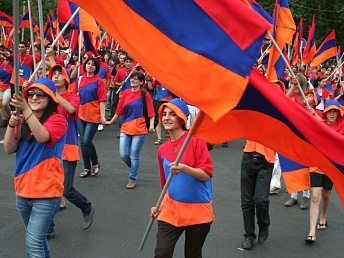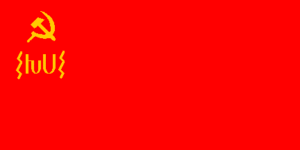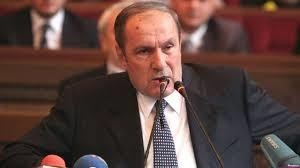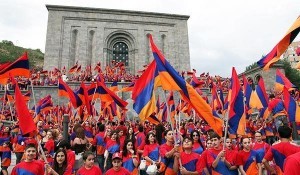After seventy years of Soviet rule, in 1991, Armenian finally declared September 21 as the Armenian Independence Day. That day undoubtedly holds a special place in the hearts of all Armenians around the world.
The Declaration of Independence
In 1991, Mikhail Gorbachev made his final efforts to prevent the fall of the Soviet Union.
On March 17, 1991, a referendum to maintain the Soviet Union was held. Almost 75 percent of the population wanted to preserve it. The Armenian, Georgian, Moldovan, Latvian, Estonian and Lithuanian republics, however, rejected the referendum.
When under Soviet rule, Armenia was a very “closed” country. So, the relations between the Armenian Soviet Socialist Republic and the Armenian Diaspora had limits.
On March 1, the Supreme Council of Armenia, at last, held its referendum on independence six months later.
The Supreme Council of Armenia validated the Declaration of Independence on August 23, 1990. The new leaders of Armenia created it. Additionally, under the declaration, Armenian Soviet Socialist Republic also got a new name – the Republic of Armenia.
Armenia held its referendum on secession from the USSR and on independence on September 21,
Consequently, a referendum on secession from the USSR and the establishment of independent statehood took place on September 21, 1991. About 95% of the Armenian citizens voted for independence. They wanted an independent and a self-governing state.
The president of the Supreme Council at that time was Levon Ter-Petrosyan. He signed the document. Aram Manukian, the parliament member, read the declaration of independence loudly for the very first time.
Declaration of Independence
The Supreme Council of the Armenian Soviet Socialist Republic
Source: Parliament
Expressing the united will of the Armenian people.;
Aware of its historic responsibility for the destiny of the Armenian people engaged in the realization of the aspirations of all Armenians and the restoration of historical justice.;
Proceeding from the principles of the Universal Declaration of Human Rights and the generally recognized norms of international law.;
Exercising the right of nations to free self-determination.;
Based on the December 1, 1989, joint decision of the Armenian SSR Supreme Council and the Artsakh National Council on the “Reunification of the Armenian SSR and the Mountainous Region of Karabakh.;”
Developing the democratic traditions of the independent Republic of Armenia established on May 28, 1918.;
Declares
The beginning of the process of establishing of independent statehood positioning the question of the creation of a democratic society based on the rule of law.;
1. The Armenian SSR is renamed the Republic of Armenia (Armenia). The Republic of Armenia shall have its flag, coat of arms, and anthem.
2. The Republic of Armenia is a self-governing state. It is endowed with the supremacy of state authority, independence, sovereignty, and plenipotentiary power. Only the Constitution and laws of the Republic of Armenia are valid for the whole territory of the Republic of Armenia.
3. The bearer of the Armenian statehood is the people of the Republic of Armenia. This exercises the authority directly and through its representative bodies. on the basis of the Constitution and laws of the Republic of Armenia. The right to speak on behalf of the people of the Republic of Armenia belongs exclusively to the Supreme Council of Armenia.
4. All citizens living on the territory of Armenia are granted citizenship of the Republic of Armenia. Armenians of the Diaspora also have the right of citizenship of Armenia.
The citizens of the Republic of Armenia are protected and aided by the Republic.
The Republic of Armenia guarantees the free and equal development of its citizens. Regardless of national origin, race, or creed.
5. With the purpose of guaranteeing the security of the Republic of Armenia and the inviolability of its borders, the Republic of Armenia creates its own armed forces, internal troops. organs of state and public security under the jurisdiction of the Supreme Council. The Republic of Armenia has its share of the USSR military apparatus.
The Republic of Armenia determines the regulation of military service for its citizens independently.
Military units of other countries, their military bases, and also building complexes can be located on the territory of the Republic of Armenia only by a decision of Armenia’s Supreme Council. The armed forces of the Republic of Armenia can be deployed only by a decision of its Supreme Council.
6. As the subject of international law, the Republic of Armenia conducts an independent foreign policy. It establishes direct relations with other states, national-state units of the USSR, and participates in the activity of international organizations.
7. The national wealth of the Republic of Armenia – the land, the earth’s crust, airspace, water, and other natural resources, as well as economic and intellectual, cultural capabilities are the property of its people. The regulation of their governance, usage, and also the possession is determined by the laws of the Republic of Armenia.
8. The Republic of Armenia determines the principles and regulation of its economic system, creates its own money, national bank, finance-loan system, tax and customs services, based on the system of multiple forms of property ownership.
9. On its territory, the Republic of Armenia guarantees freedom of speech, press, and conscience. Separation of legislative, executive, and judicial powers; a multi-party system; equality of political parties under the law; depolarization of law enforcement bodies and armed forces.
10. The Republic of Armenia guarantees the use of Armenian as the state language in all spheres of the Republic’s life. The Republic creates its own system of education and of scientific and cultural development.
11. The Republic of Armenia stands in support of the task of achieving international recognition of the 1915 Genocide in Ottoman Turkey and Western Armenia.
12. This declaration serves as the basis for the development of the Constitution of the Republic of Armenia and, until such time as the new constitution is approved, as the basis for the introduction of amendments to the current constitution; and also for the operation of state authorities and the development of new legislation for the Republic.
The Republic of Armenia with Yerevan as the capital formally declared its independence on September 21, 1991. Armenia then became a full member of the international community as a sovereign state. It also joined the United Nations in 1992.
Not to mention that it was an indescribable joy for Armenians around the world to once again have their country on the map.
Armenia adopted its Constitution on July 5, 1995, amended in 2005. This also gave the country the design of a democratic republic. The president of Armenia is the most important public official and the leading one as well.
Obviously, he is also the most powerful one. The National Assembly (the parliament, equivalent to the Congress in the United States). together with the Government (the prime minister and the cabinet), also had its share in shaping the laws of the country.
In addition, Armenia also has a Constitutional Court. It is the supreme judicial body of the country.
Armenia’s track record in terms of politics and human rights has been a challenging one since 1991.
During most elections, however, inducing people and stuffing ballot boxes a was an ordinary practice.
Despite this and other various problems, the Republic of Armenia remains the national homeland for all Armenians including the dispersed ones.
CELEBRATIONS ON ARMENIAN INDEPENDENCE DAY
 Lots of people and differents entertainers celebrate Armenian Independence Day. The celebrations begin with the Armenian national anthem. Traditionally, however, there is no particular way of celebrating this day.
Lots of people and differents entertainers celebrate Armenian Independence Day. The celebrations begin with the Armenian national anthem. Traditionally, however, there is no particular way of celebrating this day.
In other countries though, where Armenian diasporas live, they tend to get together inviting their friends for celebrating their independence day.
The national anthem is the “Mer Hayrenik” (“Our Fatherland”).
It is a poem, which wrote Mikael Nalbandian in 1859. The music composer is Barsegh Kanachian. Furthermore, the base song is an old folk song, ‘Song of an Italian girl’. “Mer Hayrenik” is the national anthem since 1918.
In addition, during 70 years of Soviet occupation, an anthem glorifying the Armenian SSR replaced it. In 1991, however, upon independence, they took the old anthem back.
Our fatherland, free and independent,
That lived from century to century
His children are calling
Free independent Armenia.
Here brother, for you a flag,
That I made with my hands
Nights I didn’t sleep,
With tears, washed it.
Look at it, 3 colors
It’s our gifted symbol.
Let it shine against the enemy.
Let Armenia always be glorious.
Everywhere death is the same
Everyone dies only once
But lucky is the one
Who is sacrificed for his nation.
Furthermore, now Armenia is on its way to build a democratic state, form a civil society. Also, improve the lives of its people.
The independence of Armenia has surely played a huge role in the lives of all people from Armenia and also its diaspora.
For a lot of countries throughout the world, statehood continues to be just a dream. Armenians are highly proud to be independent now. They had been waiting for it and also dreaming about it for a long long time, for centuries.Many Armenians have sacrificed their lives for the current independent Armenia. And, since 1991, that dream, at last, came true…
Today, both psychologically and politically Armenians are an independent nation.










Leave a Comment